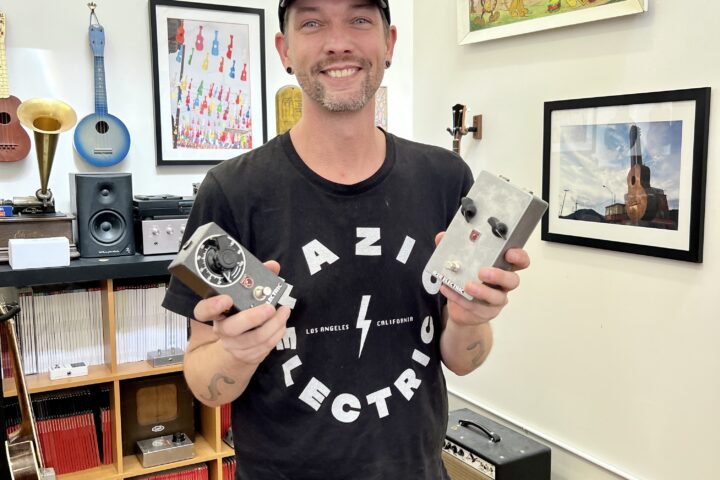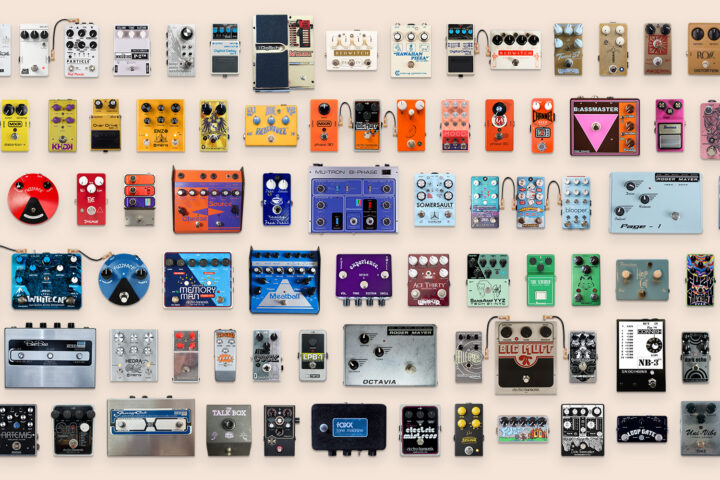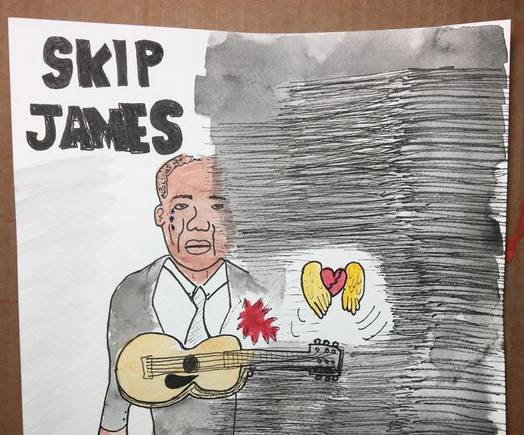File under “Sad but True” or “Good News/Bad News” – I’ve run out of identical single-knobbed pedals, but I did get my hands on three modulation pedals that (if we stretch the rules to allow for the internal trim pot in one of them) meet the criterion. Will you allow me this indulgence? I certainly hope so, because although these aren’t the most useful pedals in my bag of tricks, they were a lot more fun to put through their paces than the boosts and reverbs. Modulation effects are a huge part of so many of the songs that made me want to play electric guitar in the first place (check out the Spotify playlist this column inspired), and although I still mix a bit of phaser into my playing now and again, I got a serious kick out of having an excuse to dive deeper into this wobbly world for a while.

So, what do we got, here in the Land of Modulation? Another batch of pedals with suspect availability, reissues notwithstanding: a Dunlop-era block-letter MXR Phase 90 (with LED and a tip-positive power supply), a vintage MXR Micro Chorus (no LED, battery-only) and a Lovepdal Pickle Vibe. Would that I could have found a one-knob flanger, or scraped together the scrilla for a vintage script logo Phase 90…
And for our test rig, this time around, after getting called out last time, we took the “one-knob” thing a step further, breaking out a single-knobbed Thinline-style Tele, a single-knobbed Strat and even a Charvel San Dimas in all its EVH-inspired glory. We played through a few different amps, including a couple volume-onlies, but we did have to involve a few more knobs when we plugged into a Marshall clone (and dug out our “Brown Sound-iest” OD pedal, a Lovepedal Eternity Burst).
Lovepedal Pickle Vibe (~$100 used)
I’m going to spare you my “Vibrato vs. Tremolo” rant. Suffice to say you’ve been lied to, but by now you should know the difference. Anyway…
I once had a Fulltone Deja-Vibe. Man, that thing was rich, but its huge tones came from a big box with a massive power supply to box. It was the only pedal I had at the time, and it is the wrong pedal to have if you’re only going to have one. Years later, enter the Pickle Vibe. Given the distance in time, I’m sure it probably doesn’t measure up, sound-wise, side-by-side, but standing alone in all its miniature glory, with its LED flashing the tempo as did my best to remember how to play “Machine Gun,” it sounded pretty damn good. It’s by no means a Uni-Vibe, but it’s lush and wobbly enough to get the job done. It also, as I mentioned, stretches the “One-Knob” rules a bit: there’s an internal trim pot for the “Intensity” setting, but the theory (which I buy) is that once you find out how intense you want it you’ll be content to leave it there while you play with the single, largish chicken-head knob to vary the speed. Under the circumstances, our panel of judges decided to let this one slide…
Other things to consider: the Pickle Vibe is one of these tiny-footprint pedals, which always make me nervous on a rail-style board (there just never seems to be a way to get enough Velcro contact to make it feel stable), the switch is noiseless, without the satisfying click when it’s engaged, so keep an eye on the (nice and bright) LED, it’s true bypass and (understandably, given its size) it requires an external power supply.
MXR Micro Chorus (~$45 used, $89.99 new reissue)
I didn’t really start playing in bands until the early ‘80s, so, well… I love me some chorus. I’ve owned several different pedals over the years, plus a rack-mount delay that could do chorus and a GK 250 ML that had a built-in bona fide stereo chorus. Plus, playing in NYC, every rehearsal room and most clubs’ backlines had at least one Roland JC-120. One could argue that a single knob is absurdly confining for an effect that’s all about varying the depth and the rate, but having spent a long time living in a world where my control of chorus was “on” or “off” (on the GK) a single knob is almost an embarrassment of riches.
That one knob on this analog pedal controls the rate, which runs from a wicked slow churn that gets mighty close to a flanger’s sound to a brisk chop that’s well into vibrato territory. In between there’s the lovely tones of Andy Summers, James Honeyman-Scott, et al. – I spent a ridiculous amount of time playing that hammer-on hook from “Talk of the Town” over and over. I used “lush” to describe the Pickle Vibe, so let’s go with “rich” for the tone of the Micro Chorus – it doesn’t do the “bright” thing, really, so if you’re looking for something to use for your band’s version of “One Thing Leads to Another” this might not be it.
The vintage Micro Chorus I found was in fine shape, including the rubber cap for pedipulation (which isn’t a word, but should be). It is battery-only, for better or worse, and it’s not true bypass, for worse and only worse. The modern reissue of the pedal supports an external 9V power supply and is true bypass, which is probably worth doubling the price (though I haven’t played with one to hear if they’ve nailed recreating the tone).
MXR Phase 90 (~$50 – $350 used, depending…, $74.99 – $129.99 new block-letter, script logo, and hand-wired script logo)
I love phasers. I’m not sure who’s to blame – it’s not Eddie, though I do love how he used his Phase 90; it’s probably a combination of things, including a whole lot of phased electric piano that seeped into my ears via the radio in the 1970s. That’s a terrifying revelation for me: “Just the Way You Are” could have been just as influential on me as “Death or Glory”…
…
Whoa. Zoned out there for a second.
Anyway, I got a Homebrew Electronics Psilocybe about a decade ago and it is always on my big board, unless it’s on the small board. Wherever it is, it’s never put away. Sadly, that pedal’s got two knobs and two switches, so out I went and got a Phase 90, just for this. Do you people understand what I put myself through for you?
Phase 90s run the gamut. Generally, folks say that if you want one, you want the script logo version. That’s some seriously warm modulation, yo. When you get into the block-letter versions you start losing a sense of depth, the tone seems thinner and almost compressed (even though it’s still sweeping through the same 90 degrees). However, even amongst the script and block versions there are variations, and the early block-letter reissue version I found, with the tip-positive power supply, seems to get closer to the warmth of the script-logo versions (indeed, in the shop I played it side-by-side with a newer block-letter Phase 90 and the difference was quite apparent).
Back home, without worrying about how it stands up in comparison, it is what it is: funky, trippy, warm and soulful. Like the Micro Chorus, sweeping the knob (“Speed,” in the Phase 90’s case, rather than “Rate”) takes you through pretty much everything you expect out of a phaser. Also like the Micro Chorus, the Phase 90 plays real nice with overdrive pedals (the Pickle Vibe got a little unpleasant when things got extra-crunchy). The unit I found was in even better condition than the Micro Chorus, with its rubber cap along for the ride, but it’s not true bypass, which was particularly apparent when I tried it before and after the overdrive pedal. Once again, the reissues (block or script, 45 or 90) are true bypass; the hand-wired script logo version, however, is not true bypass and has no external power adaptor. Sadly, I’m having a hard time not going back to the shop to give further consideration to one of the script logo reissues…

Guess what… I got one of the hand-wired script logo reissues.

It’s a nice little box. A-B’ed with the block-letter version, the two are similarly wobbly-swirly, but while I wouldn’t necessarily call the script version “warmer,” it’s not as bright. Six and a half-dozer or the other? Pretty much. Clean, the block-letter had moments that felt a little shrill compared to the script, particularly at higher speeds, but paired with the overdrive pedal, that added brightness provided better definition – I’m tempted to call it “clarity,” but that seems disingenuous when we’re literally talking about distortion – while the script started to feel a little murky. Meanwhile, when the overdrive was all in pushing the amp, the script logo did a great job of taking a little bit of the edge off; it’s easy to understand why the script version is the weapon of choice for keyboard players, and why the EVH version of the pedal allows one to toggle back and forth between block-letter and script settings.
When all is said and done, though, while all of these pedals are fun and situationally functional, none of them are destined for a permanent spot on my pedalboard. Yes, having just the single knob is nice, and, frankly, I’ve forgotten what the switches on the Psilocybe actually do, but I can’t see any of these four usurping the Psilocybe’s role: A. there’s something to be said for having control over the depth of your modulation, 2. true bypass and C. external power supply.


